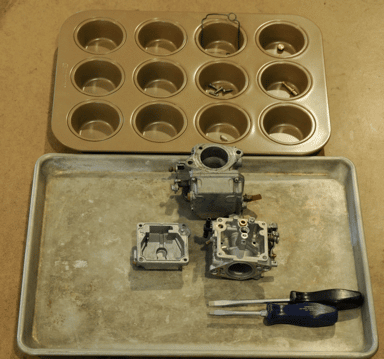
Fuel System Service
When the warmer weather finally arrives and you are ready to take the boat out on the first spring-like day, you may find your motor hard to start, running roughly, or lacks power – or in extreme cases, all of the above.
Fuel problems are probably the most common causes of drivability issues with engines, both inboard and outboard. Today’s gasolines not only deteriorate quickly forming gummy deposits but may absorb moisture over time which settles out damaging fuel system components. If you do your own fuel injection servicing or carb cleaning I have a few hints that may make things easier and less frustrating for you.
First of all safety is paramount so always work in a well-ventilated place with no open flames or smoking materials in the vicinity. Use common sense when around gasoline or other flammable products and wear eye protection as you never know what may happen. To do the job correctly, refer to the proper service manual and the latest service literature for procedures and specifications.
INSTALLING A FUEL/WATER SEPARATOR
It is best to have needed parts already at hand such as ty-raps, gaskets, and o-rings as they should be replaced whenever removed. Work slowly and pay attention to how things come apart. Use quality tools and the proper ones. Gone are the days of fixing motors with only a screwdriver and an adjustable wrench. Speaking of screwdrivers any with worn, chipped, or rounded blades should be demoted to opening paint cans. Use quality tools in good condition and be leery of any “made in China” items if you are going to use them on important tasks. For carburetor work what is called a cabinet screwdriver is invaluable. It has about the same blade width as the diameter of its shank and fits into blind holes for jet or screw removal compared to a traditional slotted screwdriver with a wider area behind its tip.
Everyone has had at least one of those ” Oh $@%! ” moments when a small fastener or part rolls off the bench to disappear on the floor for good. To minimize those aggravating occurrences kitchen items can be of assistance. Use a cookie pan with raised sides to contain any errant parts and to catch liquids that may spill during disassembly such as from a carburetor float bowl.
BOATINGLAB TESTS: FUEL STABILIZERS
Reassembly is no fun if you do not have the parts organized or at hand which means you waste time trying to figure out what item goes where, especially screws and bolts. A regular muffin tin with its dozen holes makes for a great organizational tool. Each cavity can hold the different items so they are kept together for quick access such as cover screws, carb jets, pump diaphragms, check balls, etc. Check out thrift stores and yard sales for the muffin tins and cookie sheet because dirtying your wife’s kitchen articles does not make for marital bliss.
By incorporating these hints with your DIY servicing can make any fuel repair job less time consuming with a greater chance of doing it correctly and safely the first time. That is what it is all about, isn’t it?









